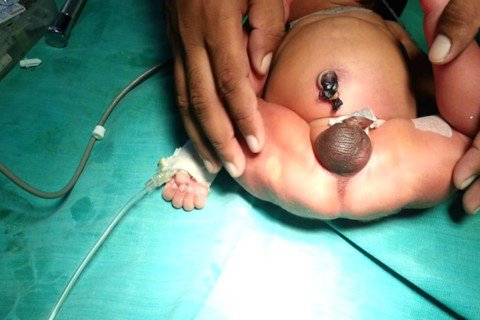Anatomy (Denis Brown)
Anus - rectal malformation has been recognized since ancient times under the common name "no anus". With advances in medicine today, babies born with this defect have been accumulated. intervention right from the first five months of life.However, depending on the deformity characteristics, anal reconstruction will be carried out in different ways, in which, anal flap surgery is the most common method. the most commonly done.
1. What is anal malformation?
Anal malformations in children are birth defects caused by problems that occur while the fetus is developing during pregnancy. With this defect, the anus and rectum cannot develop properly and affect the baby's ability to have bowel movements soon after birth.
The anus and rectum are the lower part of the digestive tract. Normally during a bowel movement, stool travels from the large intestine to the rectum and then to the anus. The sphincter in the anal area helps control the urge to defecate. To do this, nerves in the pelvis help the sphincter to sense changes in bowel movements when the urge to defecate occurs.
With an anorectal malformation, a newborn baby may experience some of the following problems:
The anal canal is narrowed. The anal opening is covered with a thin layer of skin or membrane. The rectum is not connected to the anus. The rectum connects to the urinary tract or reproductive system instead of the anus, called a rectal fistula. In fact, anorectal malformations can be detected at the same time as certain genetic syndromes or other congenital malformations such as abnormalities in the spine, heart, trachea, esophagus, kidneys, and even the kidneys. the four limbs. Some children develop genetic abnormalities of chromosomal disorders such as Down syndrome. At this time, the repair of defects in anorectal malformations will depend on the characteristics of the malformation that the child is having. At the same time, in children with associated malformations, the plan to repair the newborn's internal organs requires multi-specialist coordination.
2. How to diagnose anorectal malformation?

Dị tật hậu môn - trực tràng ở trẻ sơ sinh
Anal - rectal malformations will cause problems as soon as the child has a bowel movement. Most cases of anorectal malformations are detected before the newborn leaves the hospital. If the problem is not found in the hospital, the symptoms may be:
Slow stools coming out of the vagina Stools appearing in the urine Urine coming out of the anus Baby fusses a lot during bowel movements Quit feeding Bloating Constipation When a child has the above symptoms, the doctor will need to manually probe the child's anal passage, assess whether it is open or not, and whether stools are found. In addition, the doctor will order some supportive imaging such as X-ray of the abdomen, abdominal ultrasound, computed tomography and magnetic resonance imaging of the abdomen.
On the other hand, some children will have an indication for gastrointestinal imaging with oral contrast. This test helps to check the integrity of the anastomosis of the entire digestive tract.
3. Treatment of anorectal malformations with anorectal flap surgery
Treatment will depend on your child's symptoms, age, general condition and health. Above all, any intervention will depend on the severity of the condition.
Most children with anal-rectal anomalies will need surgery to correct the problem. In particular, anorectal flap surgery is quite popular and often applied. The reason is that this surgery is not only useful in anorectal malformation, but can also be applied to all types of lower rectum. Moreover, the types of anal canal malformations with a skin-splitting fistula with the fistula direction being parallel to the perineum can also apply anal reconstruction.
Besides, for children with narrow anal canal, the intervention now does not require surgery but instead an anal dilator. In contrast, for cases of anal hypoplasia, the rectum is not connected to the anus, requiring complex intervention with the incision on the abdominal wall.
4. How to take care of children after anal - rectal malformation intervention

Tránh để trẻ bị táo bón, tiêu phân cứng vì nó sẽ làm cho vùng hậu môn - trực tràng mới tạo hình bị tổn thương và chậm lành vết thương.
After surgery, the child's digestive tract problem cannot improve on its own without the help of parents. This process will take place for a long time, from the time the child leaves the postoperative room, during the hospital stay and especially the days of care at home.
Accordingly, after colostomy surgery, the child's defecation tract should be guided to operate from the first days. Children are still nourished according to the needs of a normal newborn or even with more energy, because most of these children are malnourished and have comorbidities. Parents need to create a conditioned reflex on the problem of defecation for the child and practice the defecation reflex in the first few months of life. Letting children suffer from constipation and hard stools will cause the newly formed anal-rectal area to be damaged and slow to heal.
On the other hand, if your child has an anorectal anomaly that requires more complex interventions, he or she may need to participate in a colon management program. This can help your child control bowel movements and actively prevent constipation. At this point, the experts will help your child to have the correct defecation reflexes with a detailed instruction program and instructions for both parents.
In summary, the anxiety of parents whose children have anal malformations will be alleviated thanks to the achievements in the field of Pediatric Surgery, especially the ano-rectal specialty. Parents need to take their children to the right specialist early so that the child can have the right surgery from the beginning, creating conditions for the child to develop in the most natural way like other children of the same age.
Recommended video:
Free surgery for children with genital defects at Vinmec
SEE MORE:
Learn about rectal - anal - vaginal fistulas Birth defect screening test Constipation in babies - What you need to know
Bài viết này được viết cho người đọc tại Sài Gòn, Hà Nội, Hồ Chí Minh, Phú Quốc, Nha Trang, Hạ Long, Hải Phòng, Đà Nẵng.






